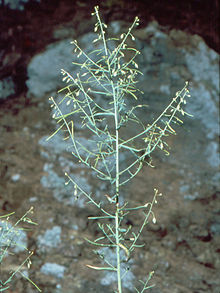| Borodinia serotina | |
|---|---|

| |
|
Scientific classification
| |
| Kingdom: | Plantae |
| Clade: | Tracheophytes |
| Clade: | Angiosperms |
| Clade: | Eudicots |
| Clade: | Rosids |
| Order: | Brassicales |
| Family: | Brassicaceae |
| Genus: | Borodinia |
| Species: | B. serotina
|
| Binomial name | |
| Borodinia serotina (E.S.Steele) P.J.Alexander & Windham
| |
| Synonyms | |
| |
Borodinia serotina is a rare species of flowering plant in the mustard family known by the common name shale barren rockcress. It is native to eastern West Virginia and western Virginia in and around the Shenandoah Valley, where it is known from 62 populations. [1] It is endemic to the shale barrens, a type of habitat characterized by steep slopes of bare shale, an exposed, rocky habitat type that is subject to very dry and hot conditions. [1] [4] Shale barrens host a number of endemics, such as Allium oxyphilum and Taenidia montana, [3] and this rockcress is among the rarest. [1] [4] It is a federally listed endangered species. [2]
Description
This is a biennial herb which has a small, inconspicuous basal rosette of leaves measuring a few centimeters wide. It bolts with an erect, branching stem that can reach a maximum height near one meter. Leaves along the stem may be 5 to 15 centimeters long, lance-shaped, and sometimes toothed along the edges. Leaves wither early, and the plant may have few or no leaves at flowering. The inflorescence is a raceme of several tiny white flowers each under a centimeter wide. The fruit is a silique measuring 4 to 8 centimeters in length and containing many small seeds.
Habitat
This endangered plant grows in mid-Appalachian shale barrens, an eroding shale scree of Devonian origin. [5] This habitat occurs in Virginia pine woodlands and is made up of unstable rock and thin soils which are largely weathered fragments of shale known as channery. [5] Most populations of the plant have a few individuals. [1] The rocky soils receive direct sunlight that makes them too hot (up to 63 °C) to support many plant species. [1]
Endangered status
The plant was listed as a federally endangered species in 1989. [3] In Virginia, it was given an S1 ranking ("Critically Imperiled") in 1991,[ citation needed] and it is currently listed as S2, "imperiled", in both Virginia and West Virginia by NatureServe. [1]
The plant is pollinated by the grizzled skipper (Pyrgus wyandot), a species of butterfly which is declining in numbers. [5] Its decline in some areas has been attributed to the use of the pesticides Dimilin and Bacillus thuringiensis to control spongy moths (Limantria dispar). [5] Other threats to the species are loss of shale barren habitat to the construction of railroads, hiking trails, and a dam. [1] Many populations are heavily browsed by deer. [1] It is not a successful competitor against introduced species such as barren brome (Bromus sterilis) and tree of heaven (Ailanthus altissima). [1]
References
- ^ a b c d e f g h i j NatureServe (1 March 2024). "Borodinia serotina". NatureServe Network Biodiversity Location Data accessed through NatureServe Explorer. Arlington, Virginia: NatureServe. Retrieved 21 March 2024.
- ^ a b "Shale barren rock cress (Boechera serotina)". Environmental Conservation Online System. U.S. Fish & Wildlife Service. Retrieved 21 March 2024.
- ^ a b c Morgan, Sharon W.; Bartgis, Rodney L.; U.S. Fish and Wildlife Service (1989). "Endangered and Threatened Wildlife and Plants; "Arabis Serotina" (Shale Barren Rock Cress) Determined to be an Endangered Species". Federal Register. 54 (133): 29655–29658. 54 FR 29655
- ^ a b Center for Plant Conservation Archived December 15, 2010, at the Wayback Machine
- ^ a b c d Nott, M. P. (2006). Shale barren rock cress (Arabis serotina): A literature review and analysis of vegetation data. A report to the Navy Information and Operations Command. Archived July 25, 2011, at the Wayback Machine

